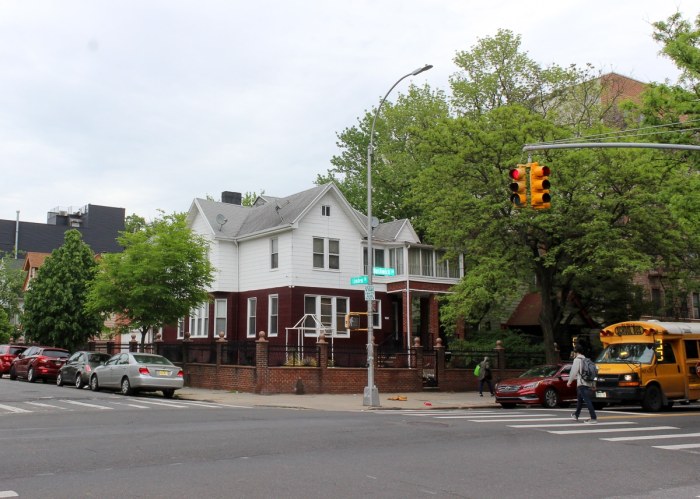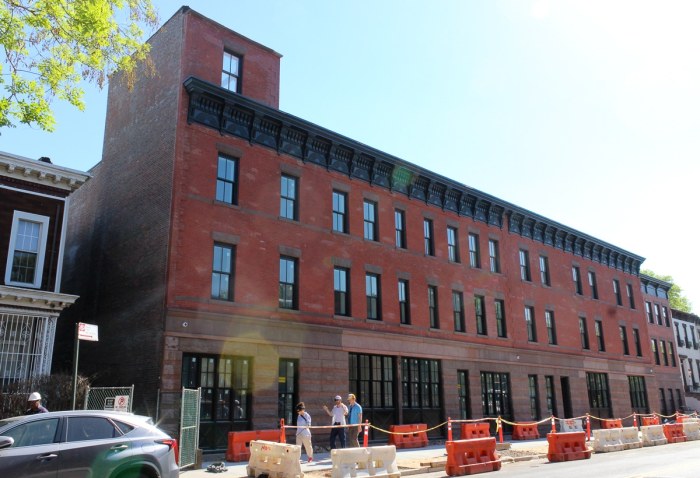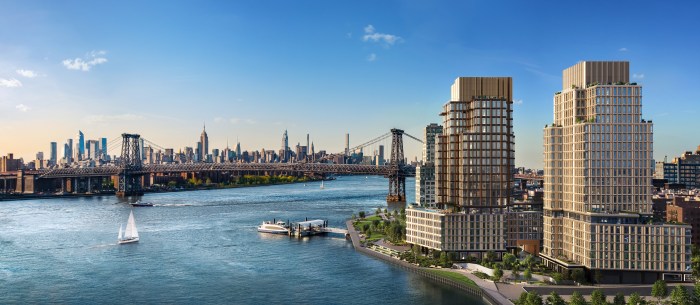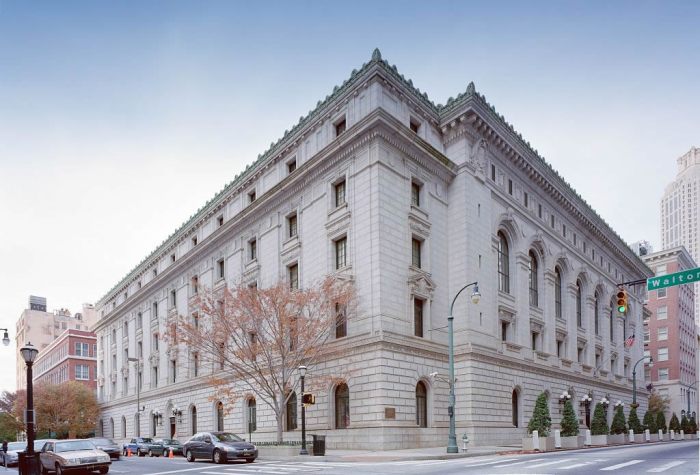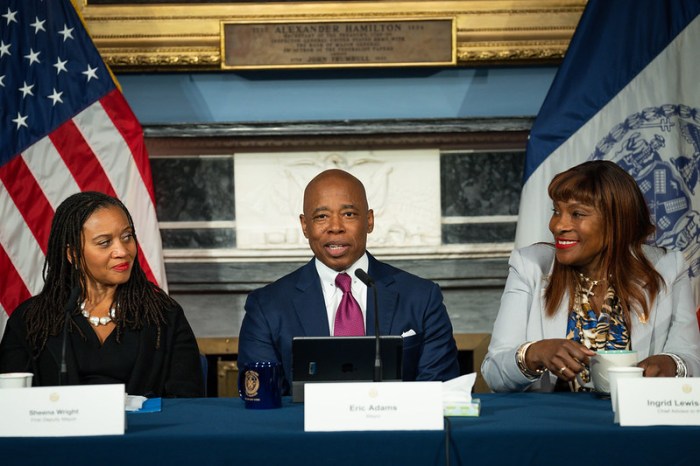Several hundred Brooklynites packed Borough Hall Wednesday night to tell
Borough President Marty Markowitz just what they think about a city plan
to convert Downtown Brooklyn into a mega-blocked, high-rise metropolis.
While most such public hearings draw just a handful of concerned citizens,
on Wednesday night more than 100 people were turned away from the main
room and forced to watch the hearing on a television screen in a room
downstairs. Nearly 100 people spoke.
“I got a hunch that I’m gonna hear plenty,” Markowitz said
before settling in for what turned out to be a five-hour hearing.
Armed with placards, signs and plenty to say, those who took the microphone
expressed a decidedly split view.
In one corner, critics raised concerns about traffic and transportation,
preserving the character of the surrounding neighborhoods, and the seizure
of private property for private developments under the state’s power
of eminent domain.
Others rallied behind the plan, saying that it would create much-needed
jobs for Brooklyn residents.
As part of the Downtown Brooklyn Plan, the government would condemn seven
acres of private land including 130 residential units, 100 businesses
and a college.
Developer Bruce Ratner’s plan for the adjacent Atlantic Yards would
have the state seize more than three square blocks of privately owned
land, a portion of which would be used to build an arena for the New Jersey
Nets basketball team, which Ratner is acquiring. The Atlantic Yards and
downtown plans overlap at the intersection of Flatbush and Atlantic avenues.
The city says the downtown plan is intended to attract businesses here
that might otherwise lease space in New Jersey or elsewhere.
Darnell Canada, leader of Brooklyn United for Innovative Development (BUILD),
a supporter of the plan, quipped, “How high this building is isn’t
important to people who don’t have a job and are out there dodging
bullets.” Noting that the unemployment rate among residents of the
nearby Walt Whitman and Farragut housing projects was well over 65 percent,
he said, “There are a lot of people who need jobs.”
Residents opposed to construction of Ratner’s $2.5 billion Nets arena,
office and apartment complex in neighboring Prospect Heights were prominent
in their attendance, urging Markowitz, a vocal proponent of that plan,
to reconsider.
The scope of change and property condemnations envisioned by the Downtown
Brooklyn Plan, together with Ratner’s Atlantic Yards site, would
alter the character of the greater downtown area and have an impact on
the neighborhoods that surround it — Fort Greene, Park Slope, Boerum
Hill, Clinton Hill, Cobble Hill and Brooklyn Heights, as well as Prospect
Heights.
Kicking off the meeting, Councilwoman Letitia James, a vocal opponent
of the arena plan whose district includes the neighboring areas of Prospect
Heights, Fort Greene and Clinton Hill, said she “supported the concept”
of the Downtown Brooklyn Plan but called for major modifications.
Those changes, she said, would include capping building heights at 250
feet, and removing the section of the plan at Flatbush and Atlantic avenues
where Ratner wants to build a 620-foot office tower as a gateway to his
arena site.
James also called for 50 percent of the housing to be designated for middle-
and low-income tenants, which she described as earning less than $40,000
a year.
Civil liberties attorney Norman Siegel, who signed on this week to represent
the residents in Prospect Heights who would be displaced to make way for
the arena, called on Markowitz to make the planning process as open as
possible.
Siegel criticized the borough president for not listing the public hearing
on his Web site and asked him to provide a full calendar of events with
explanations relating to all Downtown Brooklyn and arena plan meetings.
Residents and business owners facing eviction under the Downtown Brooklyn
Plan also testified, asking Markowitz to help protect them.
Joe Betesh, owner of Brooklyn USA, a three-story clothing store at Duffield
and Fulton streets, said his 25,000-square-foot business would be seized
if the plan goes through.
“I have 50 employees that all have families,” Betesh said at
the hearing.
The Downtown Brooklyn Plan would allow for the construction of at least
6.7 million square feet of office space, 1 million square feet of retail
space, 1,000 units of housing and 2,500 parking places.
Vincent Battista, executive director of the Institute of Design and Construction,
a college at 141 Willoughby St., on the corner of Flatbush Avenue Extension,
said that under the plan his 57-year-old college would be knocked down
to “plant grass.” An open space is slated for that location.
City Housing, Preservation and Development Commissioner Daisy Lopez outlined
compensation measures for displaced owners and met with some of them individually
during the meeting.
Councilman David Yassky, whose district includes Brooklyn Heights, DUMBO,
Downtown Brooklyn and Boerum Hill, said he supports the plan but has a
few traffic-related concerns.
“We have to make sure the surrounding residential neighborhoods are
not overrun by traffic,” said Yassky, who called on the city to implement
a pilot residential parking program for residents.
Plan supporter Canada, of BUILD, said “the last time we fought the
process, the process went forward and we got nothing,” a reference
to the construction of Metrotech, an office campus between Adams Street
and Flatbush Avenue Extension from Willoughby to Tillary streets.
Other supporters of the plan included officials from Con Edison, Keyspan,
the New York Marriott Brooklyn hotel, Polytechnic University, Long Island
University, Brooklyn Academy of Music and Brooklyn Public Library, most
of whose properties are within the plan area.
“My job is to represent the borough of Brooklyn to the best of my
ability,” Markowitz said after the last speaker finished, just before
11 pm.
Markowitz has until March 9 to submit his final recommendation, before
the plan goes for review before the City Planning Commission and then
the City Council.
“My door is always open,” Markowitz added.










